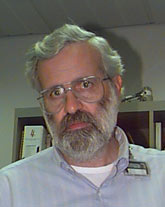
Handy Links
SLAC News Center
SLAC Today
- Subscribe
- Archives: Feb 2006-May 20, 2011
- Archives: May 23, 2011 and later
- Submit Feedback or Story Ideas
- About SLAC Today
SLAC News
Lab News
- Interactions
- Lightsources.org
- ILC NewsLine
- Int'l Science Grid This Week
- Fermilab Today
- Berkeley Lab News
- @brookhaven TODAY
- DOE Pulse
- CERN Courier
- DESY inForm
- US / LHC
SLAC Links
- Emergency
- Safety
- Policy Repository
- Site Entry Form

- Site Maps
- M & O Review
- Computing Status & Calendar
- SLAC Colloquium
- SLACspeak
- SLACspace
- SLAC Logo
- Café Menu
- Flea Market
- Web E-mail
- Marguerite Shuttle
- Discount Commuter Passes
-
Award Reporting Form
- SPIRES
- SciDoc
- Activity Groups
- Library
Stanford
Around the Bay
From the Acting Director of SSRL

From its beginnings, the Stanford Synchrotron Radiation Lightsource has had a dual relationship with the rest of SLAC. On the one hand, because SSRL was not doing high energy physics and SLAC was a single purpose laboratory, SSRL was in many ways forced to be independent and develop its own resources. However, SSRL's very existence depended on SLAC's tremendous resources, ranging from shops to the SPEAR ring itself.
As SSRL grew and eventually took over the operation of SPEAR and became part of SLAC, it developed around a vertically integrated model where most of the required resources were located within SSRL. Of course, SLAC resources for the big things were always available and gladly used. With SPEAR3, SSRL reached out even more. Many of the designs used in SPEAR3 to allow high current operation were the result of developments for the PEP-II collider, and more relationships between SSRL and the technical groups in other SLAC directorates were forged. This mode of operation has served SSRL very well over the years, enabling us to achieve up-times of over 98% this year, which is outstanding for a synchrotron radiation source. SSRL is now poised to realize the full benefits of SPEAR3 with the completion of the beamline upgrade project, successful implementation of top-off injection and receiving approval to deliver beams at currents up to 200 mA for the first time during this run cycle.
However, as evidenced by the genesis of the Linac Coherent Light Source, as the site reaches for larger and more complex projects, we must develop ways to more efficiently go from the ideas to their realization. The new organization is a very important start in that direction. This will be especially important as we move toward the realization of PEP-X.
In the development of the new organization, we in SSRL management have worked closely with Dale and his team to make sure that we will seamlessly continue on our path of delivering outstanding beams to users and finish the developments that will bring us to 500 mA using top-off injection and beyond. The integration of the accelerator activities across the lab will bring benefits to all of us who work with accelerators as we learn from each other. As time goes on, I expect that the natural interactions fostered by the new organization will allow us to move quickly to capitalize on opportunities as well as help each other in times of crisis.
—Piero Pianetta
SLAC Today, July 29, 2009